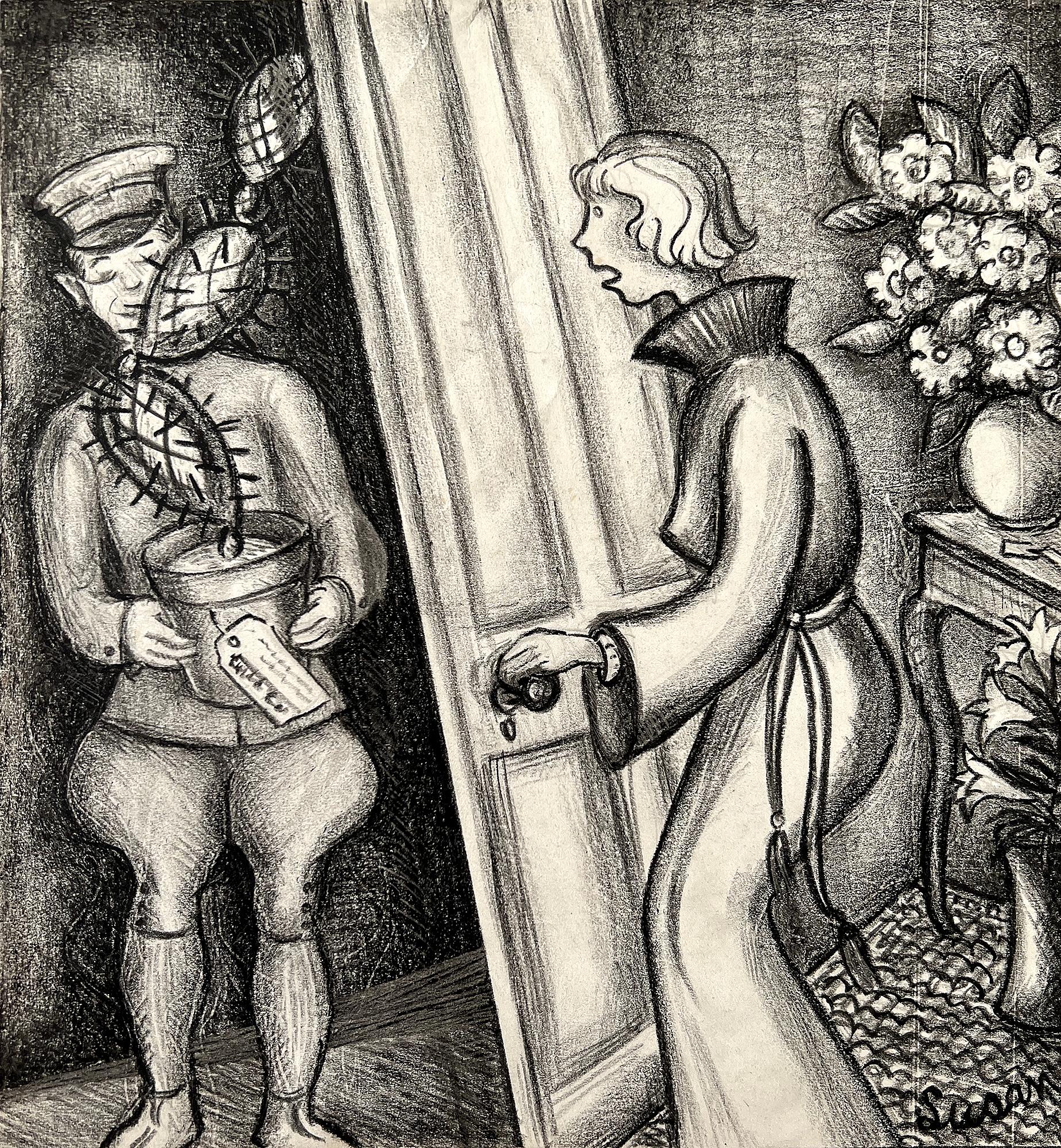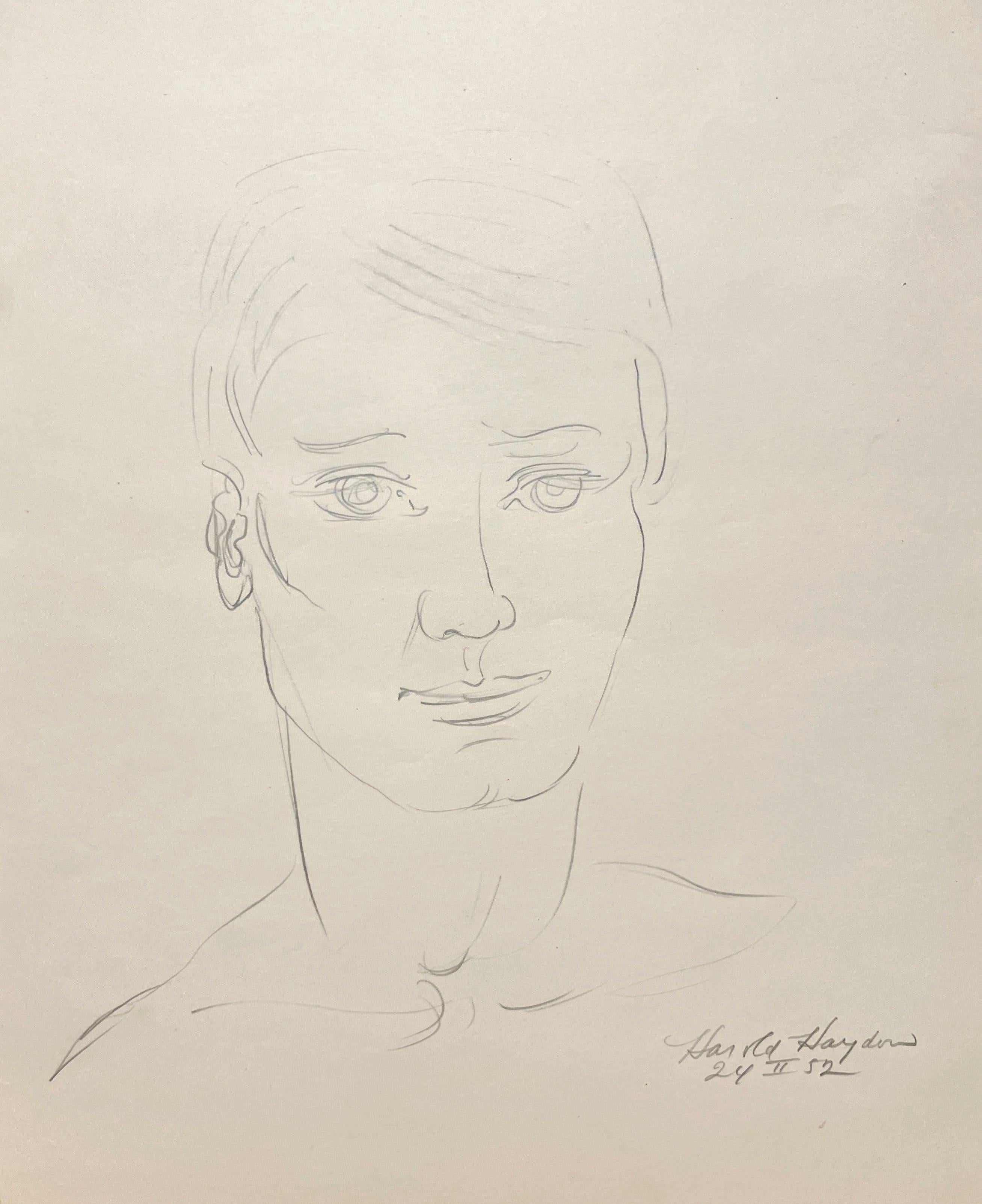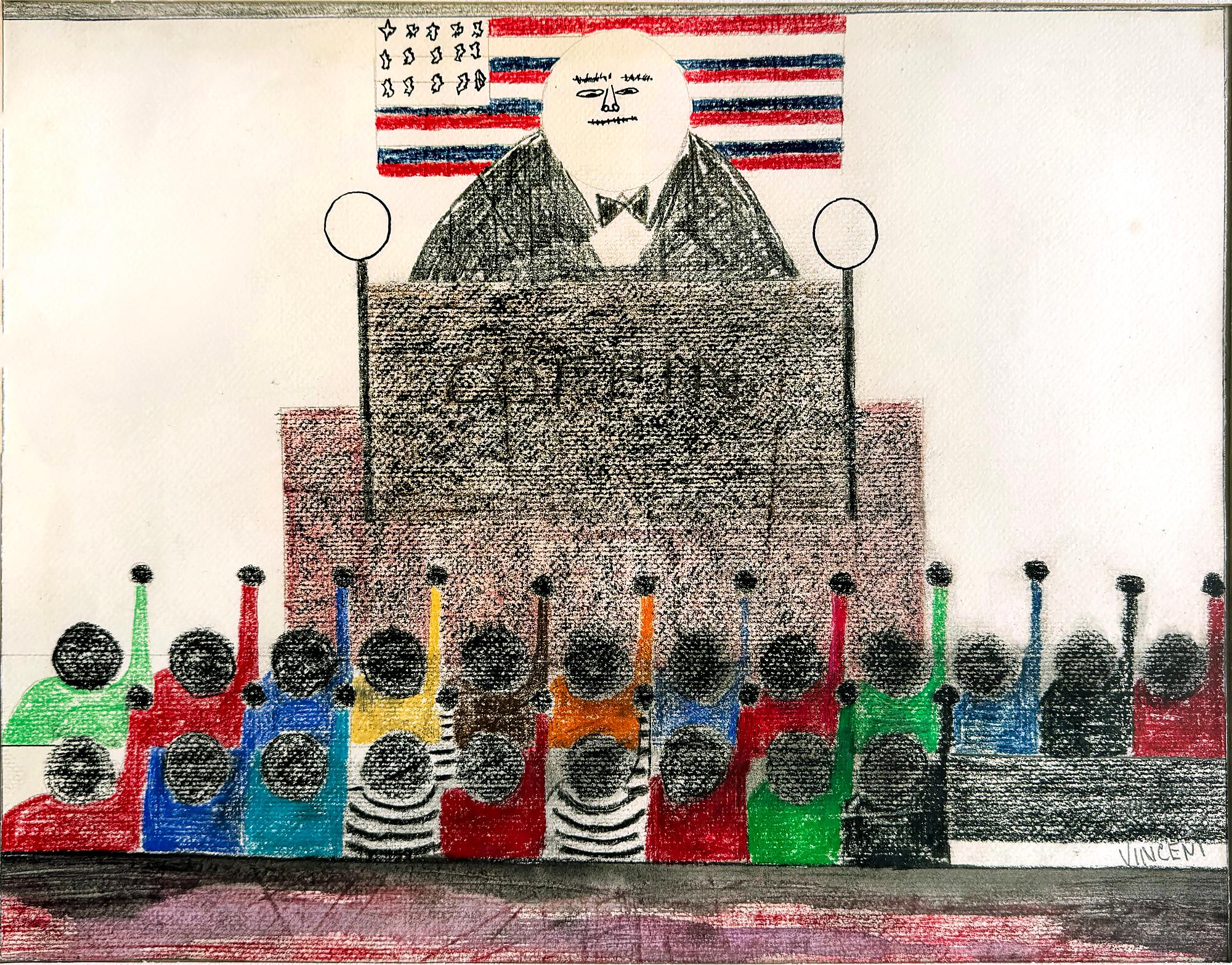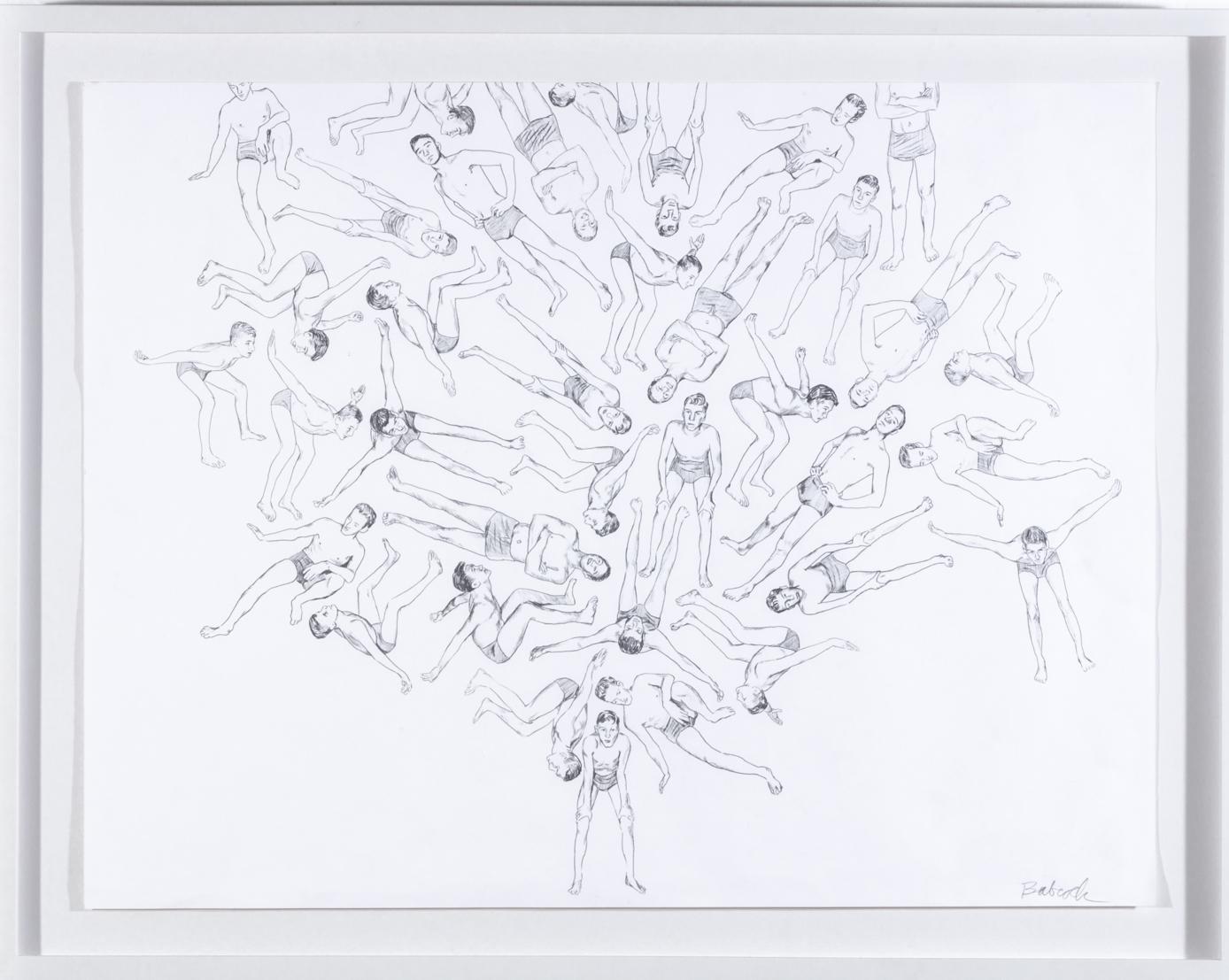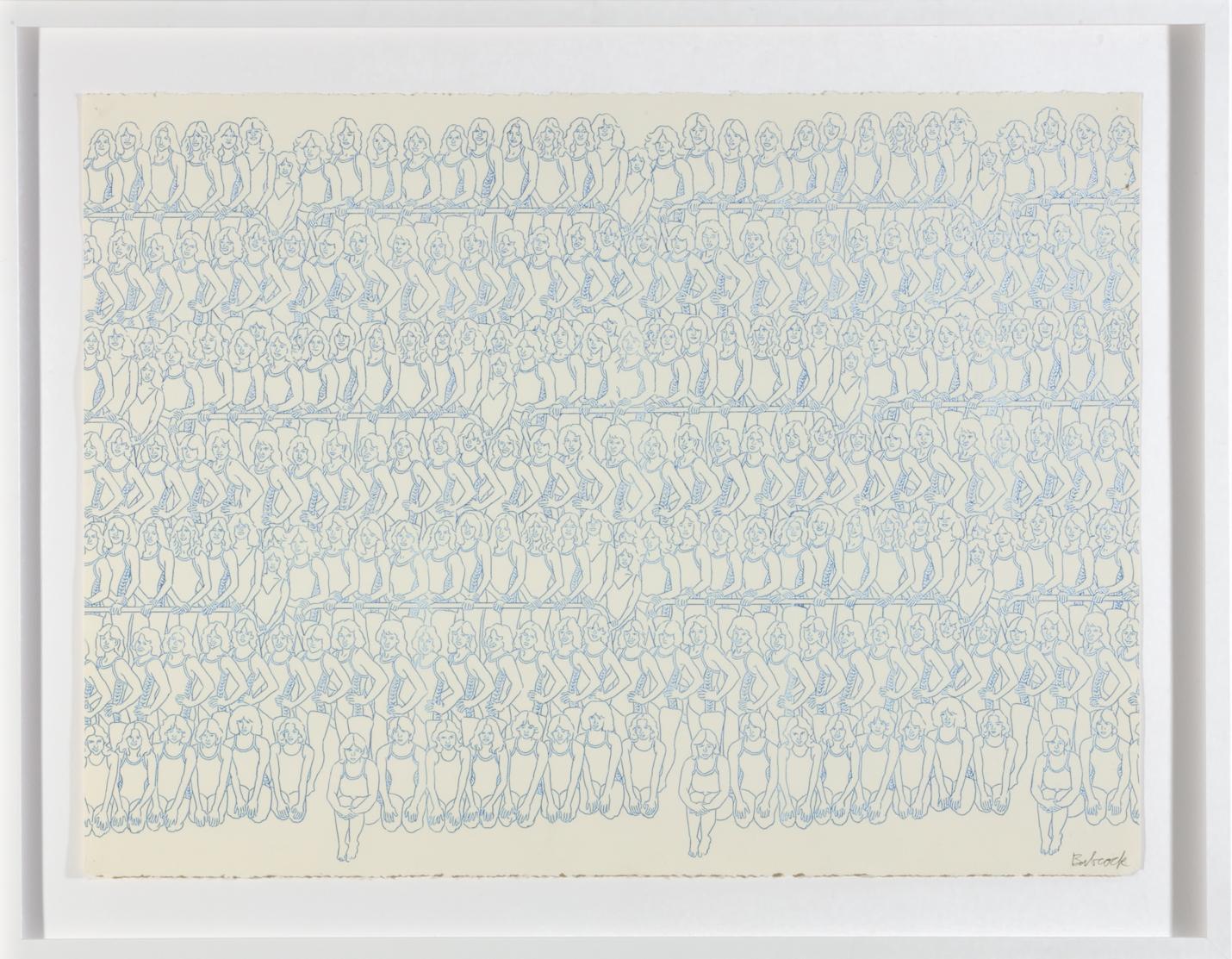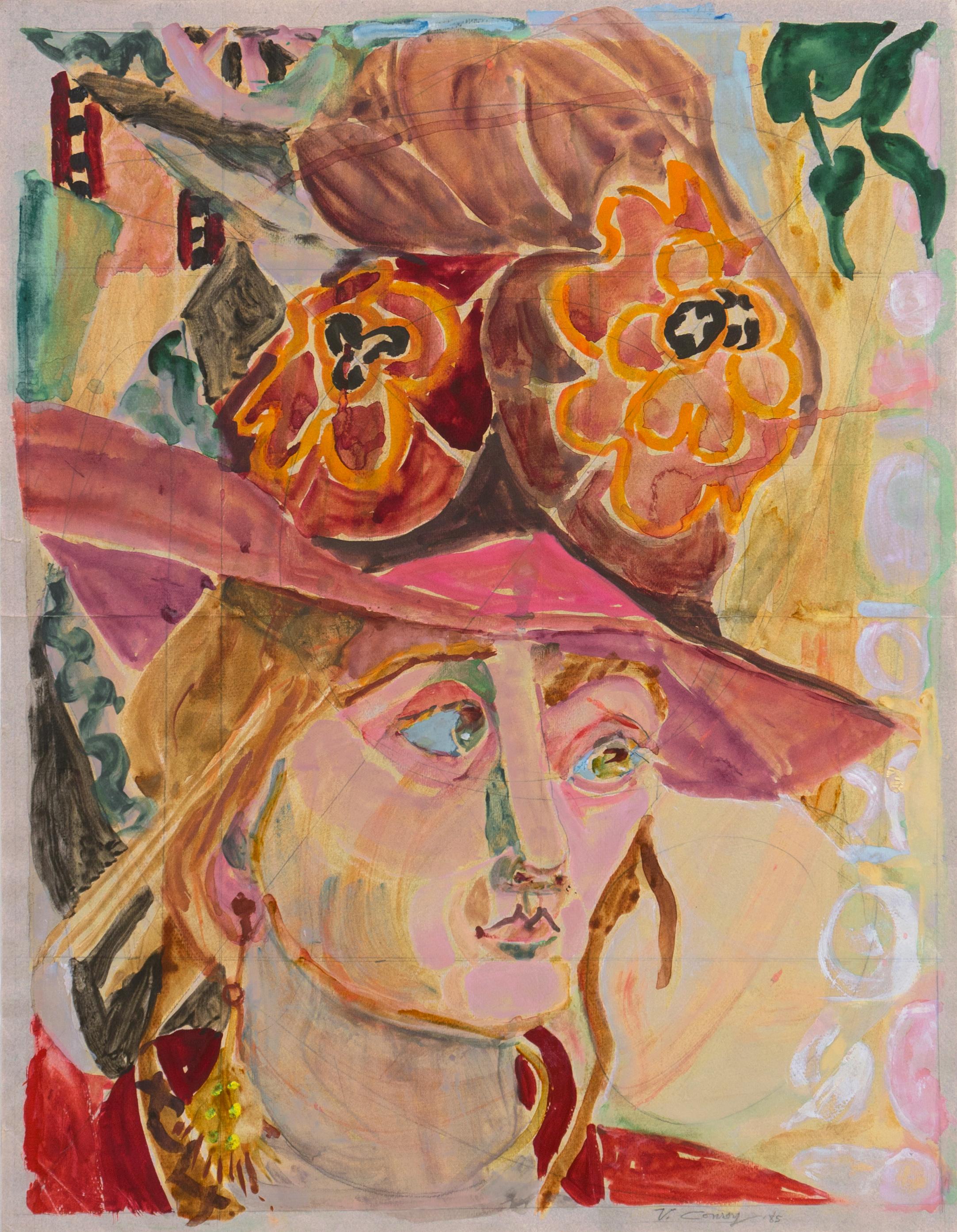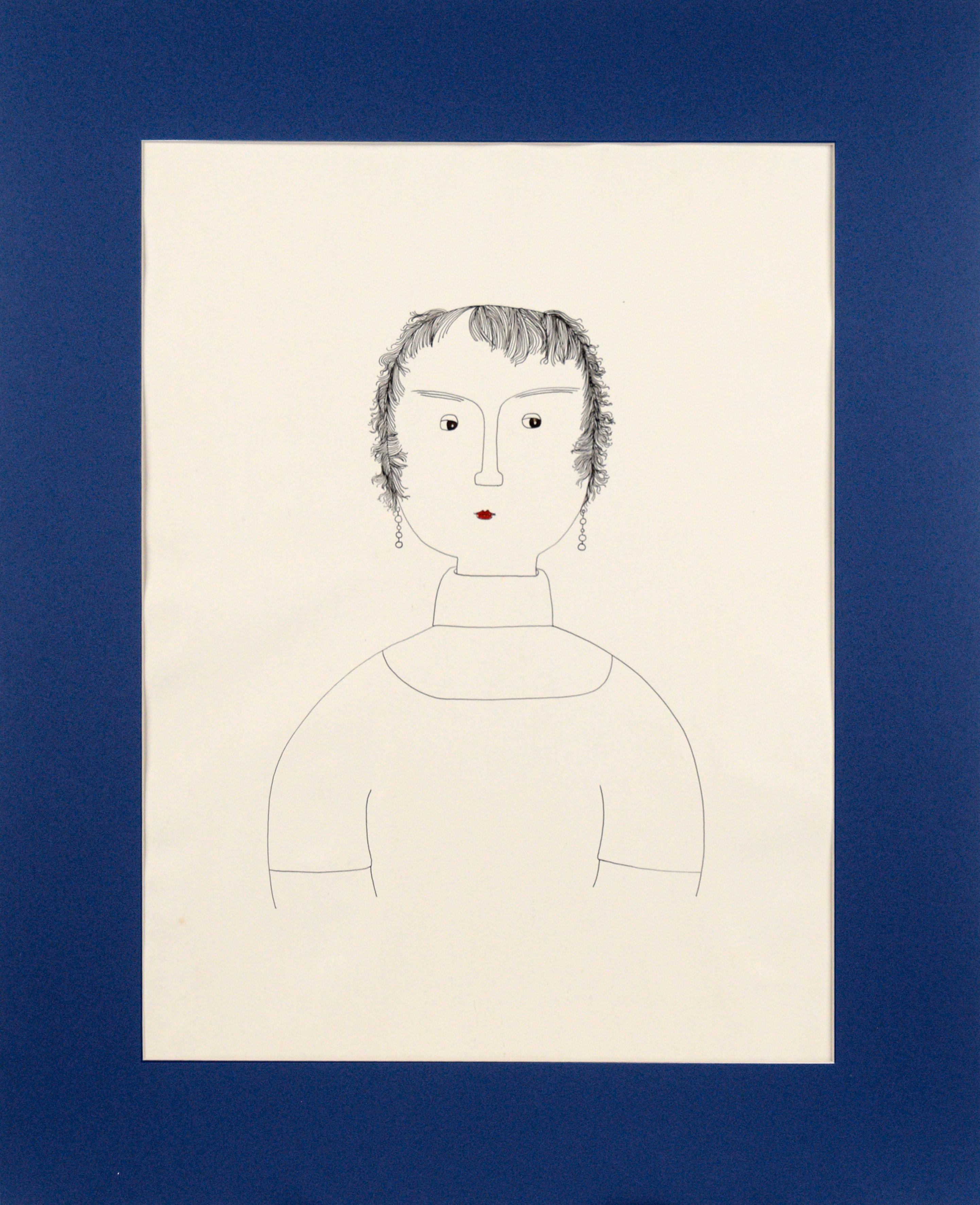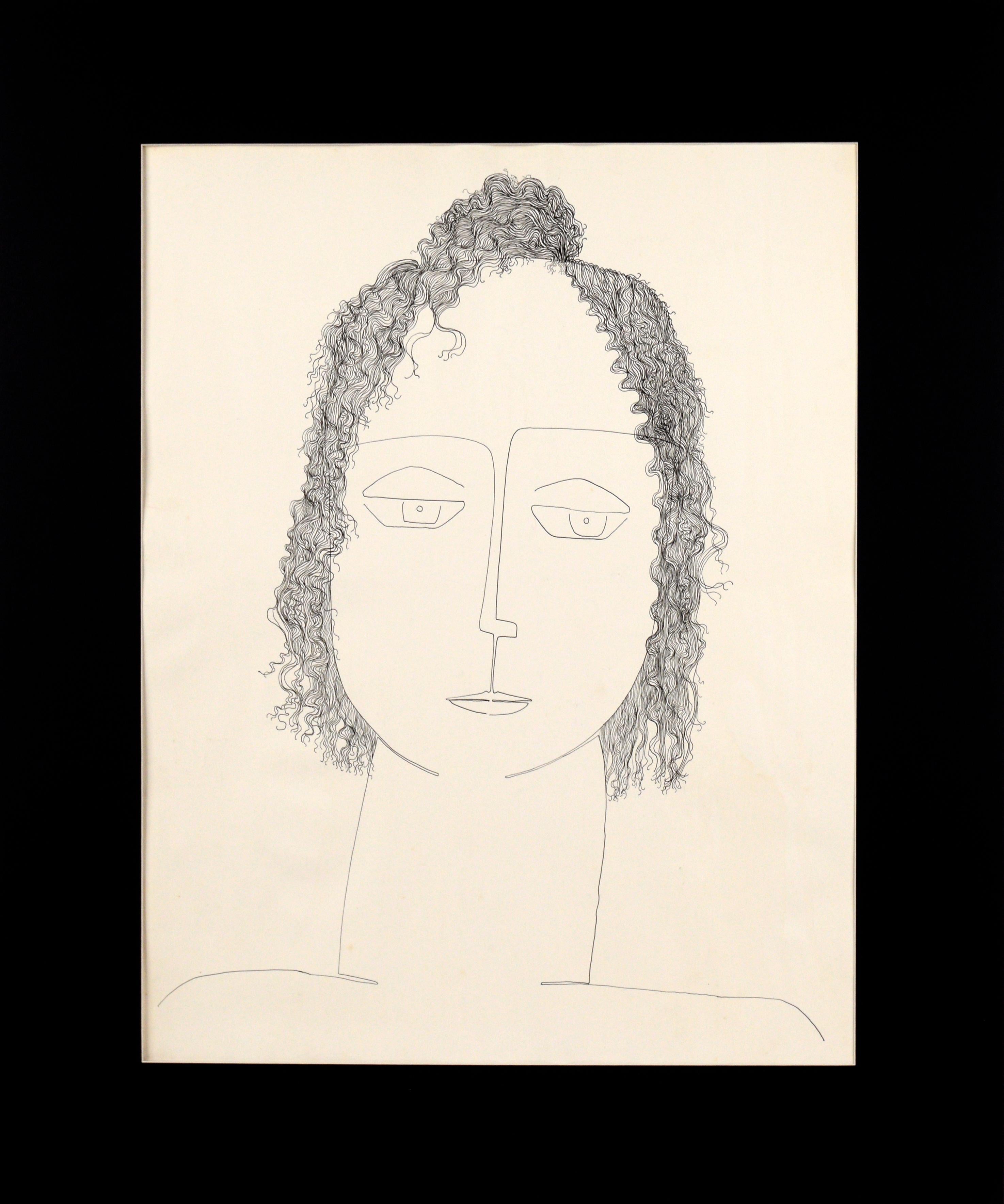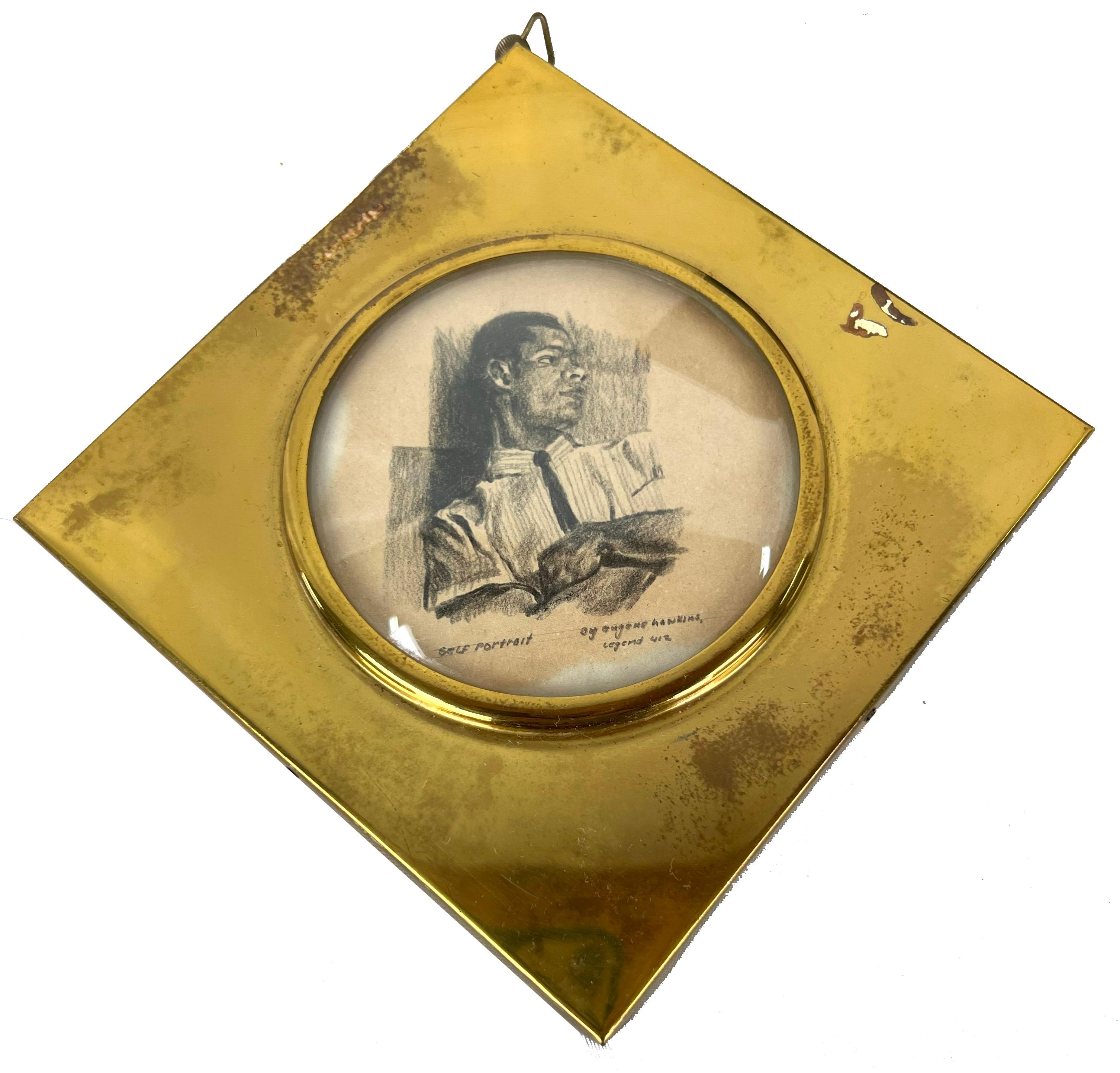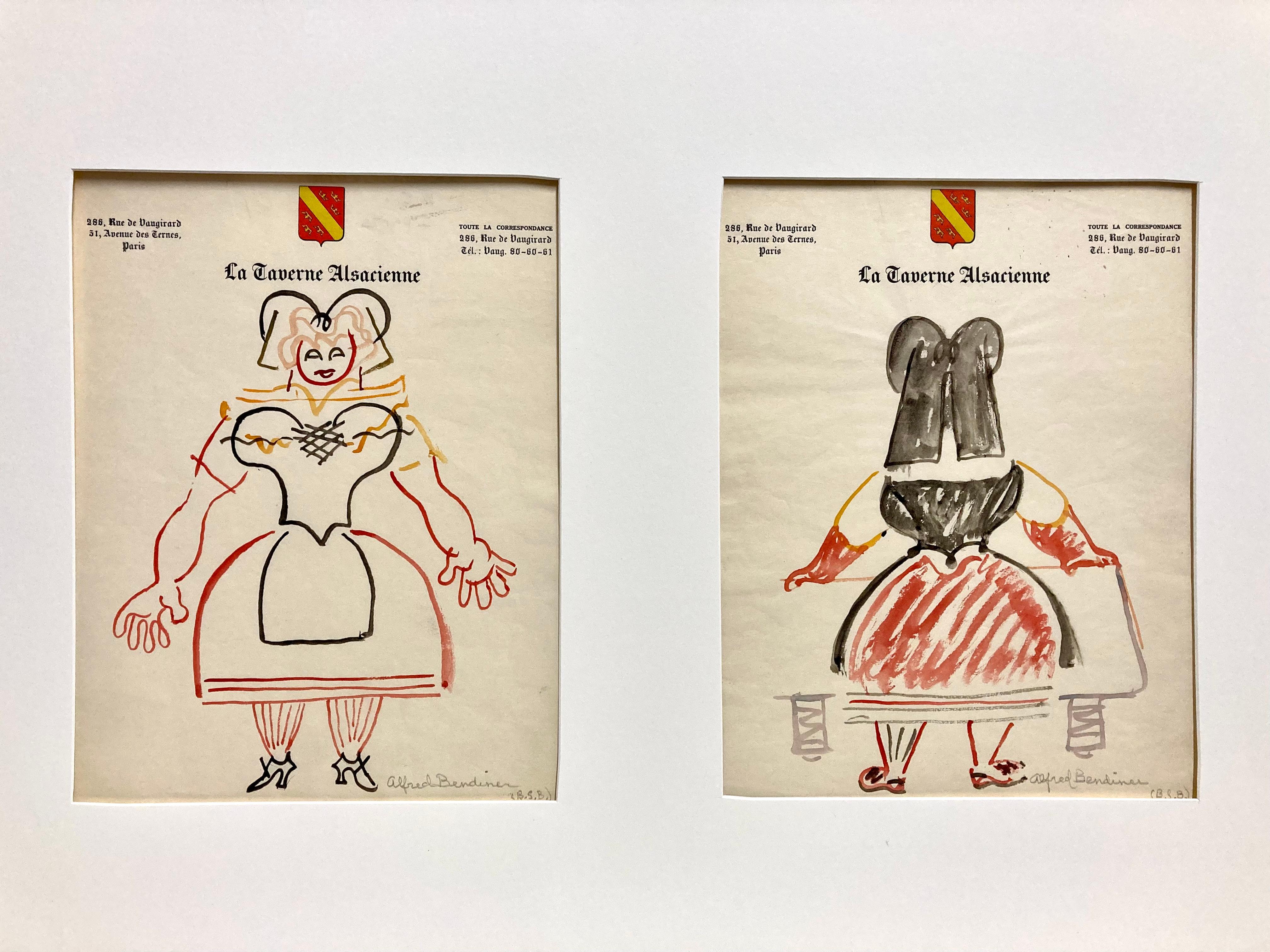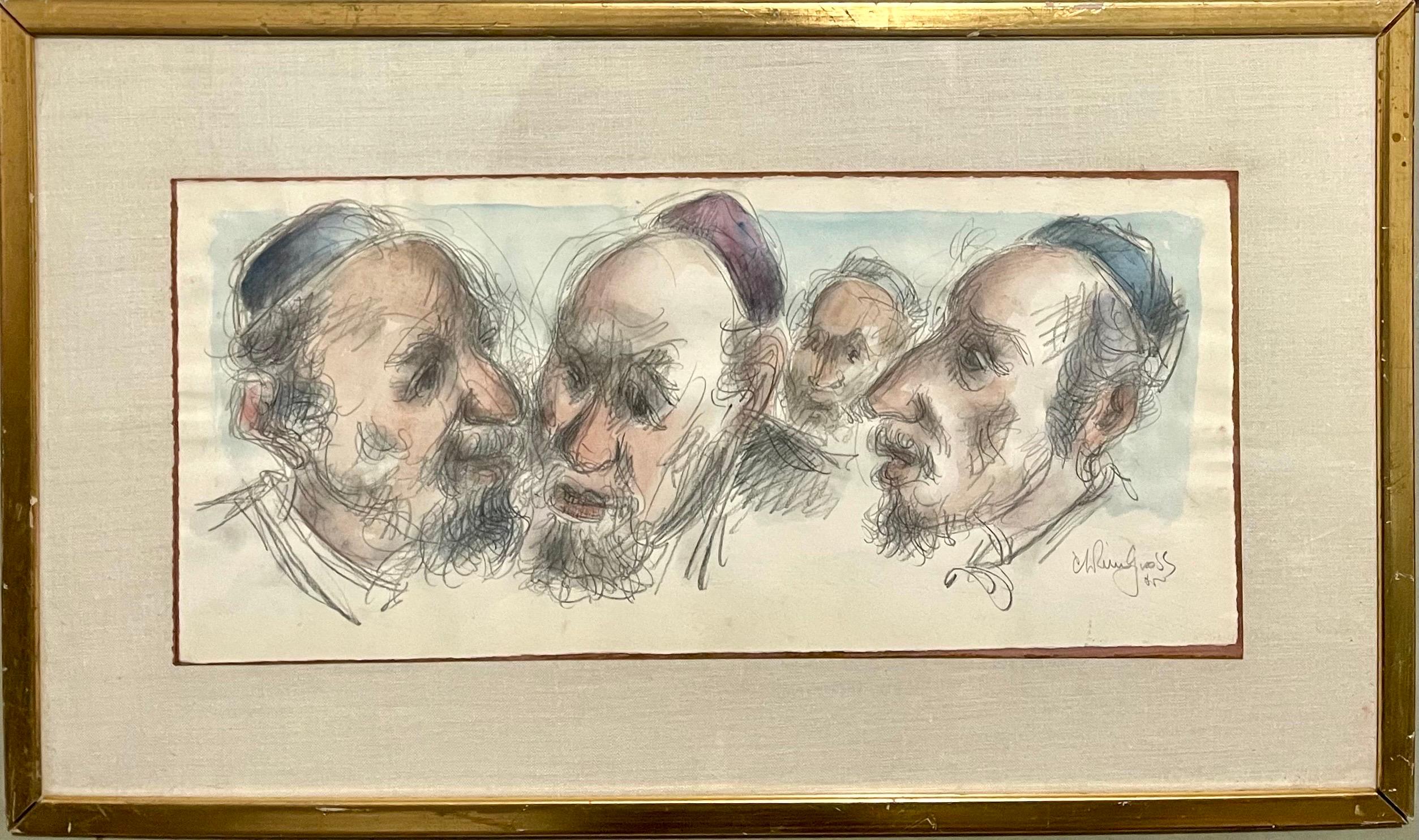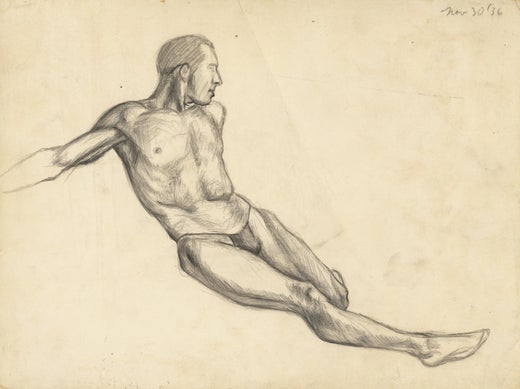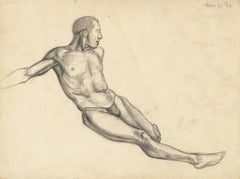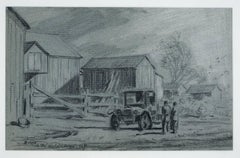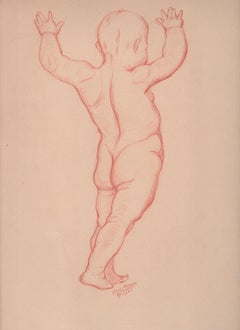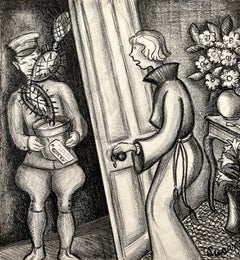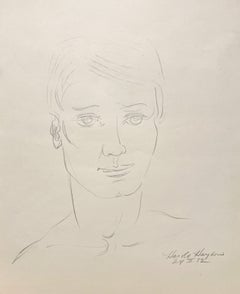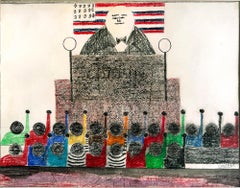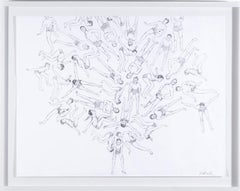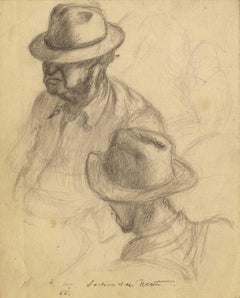
Two cattle auction attendees (for Auction Barn)
View Similar Items
Want more images or videos?
Request additional images or videos from the seller
1 of 5
Jackson Lee NesbittTwo cattle auction attendees (for Auction Barn)1988
1988
About the Item
- Creator:Jackson Lee Nesbitt (1913-2008, American)
- Creation Year:1988
- Dimensions:Height: 8 in (20.32 cm)Width: 6 in (15.24 cm)
- Medium:
- Movement & Style:
- Period:
- Condition:
- Gallery Location:New Orleans, LA
- Reference Number:1stDibs: LU841310118132
Jackson Lee Nesbitt
The catalog raisonne Jackson Lee Nesbitt / The Graphic Work was compiled by Earl Retif and Ann Salzer and published by Stone and PressJackson Lee Nesbitt, a noted printmaker and painter of the American Scene, dedicated his artistic career to the portrayal of ordinary people going about the business of their lives. Born in McAlester, Oklahoma, on June 16, 1913, Nesbitt created scenes from the Midwest He attended the Kansas City Art Institute where he learned etching from John deMartelly, attended Ross Braught's painting class, and met his future wife, Elaine Thompson, who was a costume design student. Thomas Hart Benton, who joined the faculty in the fall of 1935, quickly became a close friend and mentor to the younger artist.
In 1937 Sheffield Steel contacted deMartelly concerning an etching commission and his teacher suggested him for the job. He was commissioned to create a series of etchings illustrating different phases of the steel industry. The commission launched Nesbitt's career as a professional artist. The commission with Sheffield Steel Corporation provided the financial security that enabled Jack and Elaine Nesbitt to marry on June 1, 1938. He graduated from the Kansas City Art Institute and working as a freelance artist, Nesbitt augmented his commissioned work with genre scenes of the Midwest. He routinely went with Benton on sketching trips to rural Arkansas. The landscape and people of the Ozarks often appear in the finished work of both artists.
Associated American Artists selected one of his etchings, Watering Place, for an edition of 250 prints that were sold through subscription. Having a print published by AAA ensured national distribution.
He was awarded the Eames Prize by the Society of American Etchers in 1946, and his work was included in the book American Prize Prints of the Twentieth Century, by Albert Reese. Nesbitt taught etching (1949-1951) at the Kansas City Art Institute. In 1984 Norman and June Kraeft, (June 1 Gallery) were leading the revival of interest in early-twentieth-century American prints and convinced Nesbitt to return to printmaking. Due to problems with eyesight Nesbitt turned to lithography. From 1988 until 1993, Nesbitt created six lithographs. Five of the prints are composite images based on sketches, people, and memories of Nesbitt's life in the Midwest. Nesbitt's work is found in numerous museums and collections around the nation. His work may be found in Georgia at the Columbus Museum in Columbus and at the Morris Museum of Art in Augusta. Other institutions housing his prints and paintings include the Ackland Art Museum at the University of North Carolina in Chapel Hill; Boston Public Library in Boston, Massachusetts; Columbus Museum of Art in Columbus, Ohio; Library of Congress in Washington, D.C.; Memphis Brooks Museum of Art in Memphis, Tennessee; Muscarelle Museum of Art at the College of William and Mary in Williamsburg, Virginia; and the New Orleans Museum of Art.
Nesbitt died near Atlanta, on February 20, 2008.
About the Seller
4.9
Recognized Seller
These prestigious sellers are industry leaders and represent the highest echelon for item quality and design.
Platinum Seller
Premium sellers with a 4.7+ rating and 24-hour response times
Established in 1988
1stDibs seller since 2018
792 sales on 1stDibs
Associations
International Fine Print Dealers Association
Authenticity Guarantee
In the unlikely event there’s an issue with an item’s authenticity, contact us within 1 year for a full refund. DetailsMoney-Back Guarantee
If your item is not as described, is damaged in transit, or does not arrive, contact us within 7 days for a full refund. Details24-Hour Cancellation
You have a 24-hour grace period in which to reconsider your purchase, with no questions asked.Vetted Professional Sellers
Our world-class sellers must adhere to strict standards for service and quality, maintaining the integrity of our listings.Price-Match Guarantee
If you find that a seller listed the same item for a lower price elsewhere, we’ll match it.Trusted Global Delivery
Our best-in-class carrier network provides specialized shipping options worldwide, including custom delivery.More From This Seller
View AllCharacters from the Sketchbooks (from September Storm plus Self Portrait)
By Jackson Lee Nesbitt
Located in New Orleans, LA
This is a page from the artist's sketchbooks. Six pencil drawings show figures that might have been in preparation for future lithographs, Certainly the woman with the umbrella could have been an early iteration for September Storm. There is also a self portrait of Nesbitt. Clearly the works are authentic if unsigned. Provenance: from the Nesbitt studio.
From workers wrestling with heavy machinery to a lone horseman traveling down a rut-filled country road; from the animated crowd at a livestock auction to the dignified worshippers at a serene Sunday service; Jackson Lee Nesbitt chose to represent the essence of humanity and the nobility of ordinary folk striving to get along as best they can. He studied with Thomas Hart Benton and John Demartelly...
Category
Late 20th Century American Modern Figurative Drawings and Watercolors
Materials
Graphite
Male Lying Nude - In Celebration of Pride Month
By Jackson Lee Nesbitt
Located in New Orleans, LA
Stone and Press Gallery is excited to offer several works in celebration of the LGBTQ community.
This is a drawing from the artist's sketchbooks. This pencil drawing shows a nude male in repose, The drawing is dated November 30 '36 (1936). Clearly the works are authentic and this sketch is signed "Jackson Lee Nesbitt...
Category
Late 20th Century American Modern Nude Drawings and Watercolors
Materials
Graphite
$200 Sale Price
20% Off
Barns in the Helderberg, New York (rural 1930s American scene with vintage car)
By Martin Lewis
Located in New Orleans, LA
"Barns in the Helderberg, New York" by Martin Lewis shows neighbors (one in a Model T car) visiting outside a series of barns with a tree in the background...
Category
1930s American Modern Landscape Drawings and Watercolors
Materials
Chalk, Charcoal
Statue of Young Boy in Fountain on the Plaza
By Jackson Lee Nesbitt
Located in New Orleans, LA
This very early original red conte drawing is signed "Jack L. Nesbitt, 4/21/34". On the back of the drawing, Nesbitt has written "Quick sketch from fountain on Plaza". Jack was a student of Thomas Hart Benton at the Kansas City Art Institute during this period. The figure on the drawing is of a nude young boy with both arms in the air. A very rare early work by this fine artist.
Jackson Lee Nesbitt, a noted printmaker and painter of the American Scene, dedicated his artistic career to the portrayal of ordinary people going about the business of their lives. A native of Oklahoma, Nesbitt created scenes from the Midwest during the 1930s and 1940s, but in the 1950s, when interest in his work diminished, he moved to Atlanta and established a second career in advertising. Thirty years later, Nesbitt sold his business and resumed his artistic career from Atlanta.
He was born in McAlester, Oklahoma, on June 16, 1913, the only child of LuCena Grant and Howard Nesbitt. The family resided in Muskogee, Oklahoma, where his father owned a commercial printing business. Jack, as Nesbitt was known, helped out in the family business until 1931, when he enrolled at the University of Oklahoma in Norman.
Two years later Nesbitt enrolled at the Kansas City Art Institute in Missouri. As a first-year student, he learned etching from John deMartelly, attended Ross Braught's painting class, and met his future wife, Elaine Thompson, who was a costume design student. Thomas Hart Benton, who joined the faculty in the fall of 1935, quickly became a close friend and mentor to the younger artist.
In 1937 the management of the Sheffield Steel Corporation contacted deMartelly concerning an etching commission. Because Nesbitt was an outstanding student, his teacher suggested him for the job. When Nesbitt arrived at the plant one afternoon, he was taken to the open-hearth furnace area, where he diligently sketched anonymous workers in that dramatic setting until five o'clock the following morning. On the strength of his sketches, he was commissioned to create a series of etchings illustrating different phases of the steel industry. The commission launched Nesbitt's career as a professional artist.
The commission with Sheffield Steel Corporation provided the financial security that enabled Jack and Elaine Nesbitt to marry on June 1, 1938. He graduated from the Kansas City Art Institute about the same time. Working as a freelance artist, Nesbitt augmented his commissioned work with genre scenes of the Midwest, and he routinely went with Benton on sketching trips to rural Arkansas.
Beginning in 1939 Nesbitt's work gained widespread recognition. Open Hearth Door, a Sheffield Steel Corporation painting, was chosen to represent Missouri in the American Art Today exhibition at the New York World's Fair. Associated American Artists selected one of his etchings, Watering Place, for an edition of 250 prints that were sold through subscription. Having a print published by the association ensured national distribution, and four more of Nesbitt's works, all of rural southern genre scenes, were later selected by the print publisher.
Over the next decade Nesbitt's work was exhibited in California, Colorado, Illinois, Missouri, New York, and Oklahoma. He was awarded the Eames Prize by the Society of American Etchers in 1946, and his work was included in the book American Prize Prints of the Twentieth Century, by Albert Reese. Major corporations with operations in the Midwest, including Brown and Bigelow, Butler Manufacturing Company, Humble Oil and Refining Company, Omaha Steel Works, Pratt and Whitney...
Category
1930s American Modern Figurative Drawings and Watercolors
Materials
Conté
Resting Man (Man relaxes draped only in a small towel) - In Celebration of Pride
Located in New Orleans, LA
Stone and Press Gallery is excited to offer several works in celebration of the LGBTQ community.
A rare pencil drawing by John Lear created in 1937, signed and dated in pencil.
John Brock Lear...
Category
1930s Academic Nude Drawings and Watercolors
Materials
Pencil, Graphite
Nude woman lying - In Celebration of Pride Month
By Tom Leveritt
Located in New Orleans, LA
Stone and Press Gallery is excited to offer several works in celebration of the LGBTQ community.
A pencil drawing with ink wash
Tom Leveritt (1976) was ...
Category
2010s Modern Figurative Drawings and Watercolors
Materials
Ink, Pencil
$480 Sale Price
20% Off
You May Also Like
Surprised Woman with Cactus 1920s Female Illustrator
By Susan Flint
Located in Miami, FL
The postman's delivery of a limp cactus creates a big emotional response the female recipient. Most likely an interior illustration for a newsstand magazine. Signed lower right Sus...
Category
1930s American Modern Figurative Drawings and Watercolors
Materials
Paper, Graphite
A Sensitive 1950s Mid-Century Modern Portrait of a Young Man By Harold Haydon
By Harold Haydon
Located in Chicago, IL
A Sensitive, Finely Rendered 1950s Mid-Century Modern Portrait of a Young Man By Noted Chicago Artist, Harold Haydon (Am. 1909-1994). Artwork size: 12 x 9 1/2 inches. Artwork is un...
Category
Mid-20th Century American Modern Portrait Drawings and Watercolors
Materials
Paper, Graphite
Black Panther Trials - Civil Rights Movement Police Violence African American
Located in Miami, FL
The Black Panther Trials - In this historically significant work, African American Artist Vicent D. Smith functions as an Art Journalist/ Court Reporter as much as a
Artist. Here, he depicts, in complete unity, 21 Black Panther Protestors raising their fist of defiance at the White Judge. Smith's composition is about utter simplicity, where the Black Panther Protestors are symmetrically lined up in a confrontation with a Judge whose size is exaggerated in scale. Set against a stylized American Flag, the supercilious Judge gazes down as the protesters as their fists thrust up. Signed Vincent lower right. Titled Panter 21. Original metal frame. Tape on upper left edge of frame. 255 . Panther 21. Framed under plexi.
_____________________________
From Wikipedia
In 1969-1971 there was a series of criminal prosecutions in New Haven, Connecticut, against various members and associates of the Black Panther Party.[1] The charges ranged from criminal conspiracy to first-degree murder. All charges stemmed from the murder of 19-year-old Alex Rackley in the early hours of May 21, 1969. The trials became a rallying-point for the American Left, and marked a decline in public support, even among the black community, for the Black Panther Party
On May 17, 1969, members of the Black Panther Party kidnapped fellow Panther Alex Rackley, who had fallen under suspicion of informing for the FBI. He was held captive at the New Haven Panther headquarters on Orchard Street, where he was tortured and interrogated until he confessed. His interrogation was tape recorded by the Panthers.[2] During that time, national party chairman Bobby Seale visited New Haven and spoke on the campus of Yale University for the Yale Black Ensemble Theater Company.[3] The prosecution alleged, but Seale denied, that after his speech, Seale briefly stopped by the headquarters where Rackley was being held captive and ordered that Rackley be executed. Early in the morning of May 21, three Panthers – Warren Kimbro, Lonnie McLucas, and George Sams, one of the Panthers who had come East from California to investigate the police infiltration of the New York Panther chapter, drove Rackley to the nearby town of Middlefield, Connecticut. Kimbro shot Rackley once in the head and McLucas shot him once in the chest. They dumped his corpse in a swamp, where it was discovered the next day. New Haven police immediately arrested eight New Haven area Black Panthers. Sams and two other Panthers from California were captured later.
Sams and Kimbro confessed to the murder, and agreed to testify against McLucas in exchange for a reduction in sentence. Sams also implicated Seale in the killing, telling his interrogators that while visiting the Panther headquarters on the night of his speech, Seale had directly ordered him to murder Rackley. In all, nine defendants were indicted on charges related to the case. In the heated political rhetoric of the day, these defendants were referred to as the "New Haven Nine", a deliberate allusion to other cause-celebre defendants like the "Chicago Seven".
The first trial was that of Lonnie McLucas, the only person who physically took part in the killing who refused to plead guilty. In fact, McLucas had confessed to shooting Rackley, but nonetheless chose to go to trial.
Jury selection began in May 1970. The case and trial were already a national cause célèbre among critics of the Nixon administration, and especially among those hostile to the actions of the FBI. Under the Bureau's then-secret "Counter-Intelligence Program" (COINTELPRO), FBI director J. Edgar Hoover had ordered his agents to disrupt, discredit, or otherwise neutralize radical groups like the Panthers. Hostility between groups organizing political dissent and the Bureau was, by the time of the trials, at a fever pitch. Hostility from the left was also directed at the two Panthers cooperating with the prosecutors. Sams in particular was accused of being an informant, and lying to implicate Seale for personal benefit.
In the days leading up to a rally on May Day 1970, thousands of supporters of the Panthers arrived in New Haven individually and in organized groups. They were housed and fed by community organizations and by sympathetic Yale students in their dormitory rooms. The Yale college dining halls provided basic meals for everyone. Protesters met daily en masse on the New Haven Green across the street from the Courthouse (and one hundred yards from Yale's main gate). On May Day there was a rally on the Green, featuring speakers including Jean Genet, Abbie Hoffman, Jerry Rubin, and John Froines (an assistant professor of chemistry at the University of Oregon). Teach-ins and other events were also held in the colleges themselves.
Towards midnight on May 1, two bombs exploded in Yale's Ingalls Rink, where a concert was being held in conjunction with the protests.[4] Although the rink was damaged, no one was injured, and no culprit was identified.[4]
Yale chaplain William Sloane Coffin stated, "All of us conspired to bring on this tragedy by law enforcement agencies by their illegal acts against the Panthers, and the rest of us by our immoral silence in front of these acts," while Yale President Kingman Brewster Jr. issued the statement, "I personally want to say that I'm appalled and ashamed that things should have come to such a pass that I am skeptical of the ability of a Black revolutionary to receive a fair trial anywhere in the U.S." Brewster's generally sympathetic tone enraged many of the university's older, more conservative alumni, heightening tensions within the school community.
As tensions mounted, Yale officials sought to avoid deeper unrest and to deflect the real possibility of riots or violent student demonstrations. Sam Chauncey has been credited with winning tactical management on behalf of the administration to quell anxiety among law enforcement and New Haven's citizens, while Kurt Schmoke, a future Rhodes Scholar, mayor of Baltimore, MD and Dean of Howard University School of Law, has received kudos as undergraduate spokesman to the faculty during some of the protest's tensest moments. Ralph Dawson, a classmate of Schmoke's, figured prominently as moderator of the Black Student Alliance at Yale (BSAY).
In the end, compromises between the administration and the students - and, primarily, urgent calls for nonviolence from Bobby Seale and the Black Panthers themselves - quashed the possibility of violence. While Yale (and many other colleges) went "on strike" from May Day until the end of the term, like most schools it was not actually "shut down". Classes were made "voluntarily optional" for the time and students were graded "Pass/Fail" for the work done up to then.
Trial of McLucas
Black Panther trial sketch...
Category
1970s American Modern Figurative Drawings and Watercolors
Materials
Watercolor, Pen, Pencil, Paper
Divers
By Jay Alan Babcock
Located in Saint Louis, MO
Jay Alan Babcock is a St. Louis-based graphic designer and painter. His work exhibits his interest in the visual language of Americana, including old ...
Category
2010s American Modern Portrait Drawings and Watercolors
Materials
Carbon Pencil
Swim Team
By Jay Alan Babcock
Located in Saint Louis, MO
Jay Alan Babcock is a St. Louis-based graphic designer and painter. His work exhibits his interest in the visual language of Americana, including old ...
Category
2010s American Modern Portrait Drawings and Watercolors
Materials
Carbon Pencil
"Contemplation"
By Gershon Benjamin
Located in Lambertville, NJ
Jim’s of Lambertville is proud to offer this artwork by:
Gershon Benjamin (1899-1985)
An American Modernist of portraits, landscapes, still lives, and the urban scene, Gershon Benj...
Category
1920s Modern Figurative Drawings and Watercolors
Materials
Graphite
Recently Viewed
View AllMore Ways To Browse
Jackson Lee Nesbitt On Sale
Woman Charcoal Drawing
Black Female Nude Drawings
Prix De Rome Drawings
20th Century Japanese Watercolor Painting
Graphite And Charcoal Drawings
Antique Pen And Ink Drawings
Vogue Illustration
Antique Technical Drawings
Charcoal Drawing Of Man
Monterey Watercolor Art
K King
French Graphite Drawings
Antique Chalk Art
Watercolor Painting Ballet
19th Century French Pencil Drawing
Art Deco Pencil Drawings
Pen And Ink Sketch
